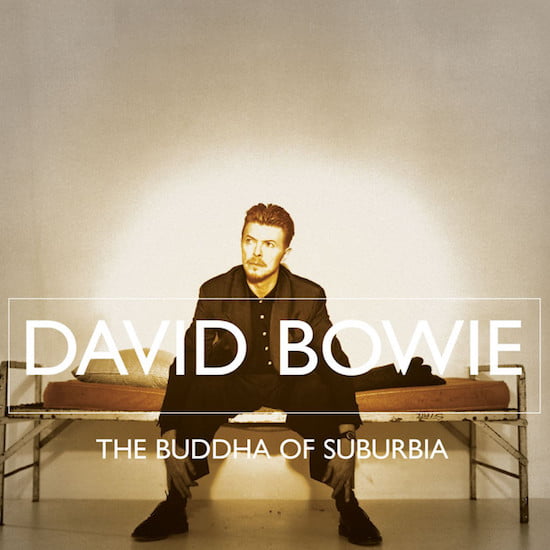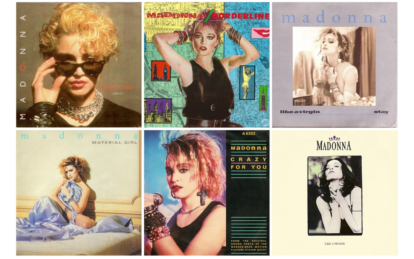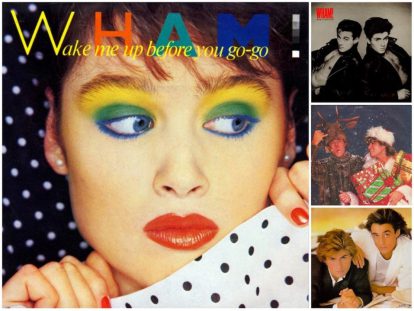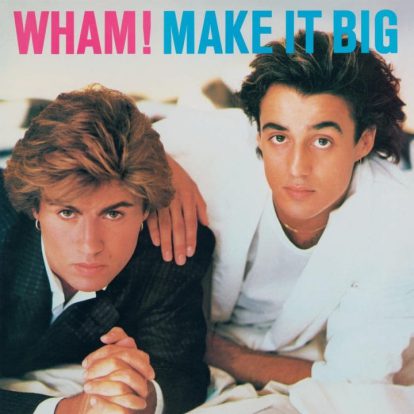In our list of the best alternative David Bowie songs of the 80s and 90s we delve deep into the singer’s stellar back catalogue… By Andy Price
20 Heaven’s In Here, Tin Machine (1989)
The first track on Tin Machine’s first record is among its more engaging moments, with a traction engine of a riff grinding the band into bluesy motion. Bowie’s vocal and stylistic debt to Iggy Pop is fairly obvious: an association made transparent with the fact that Iggy’s one-time rhythm section – the infamous Sales brothers – provide the pounding bedrock. Due to Tin Machine’s policy of only allowing first-take, instinctual approaches to songcraft, the lyric is somewhat duff by Bowie’s standards. Yet the collective intensity of the song conceals it.
19 ’87 and Cry, Never Let Me Down (1987)
Never Let Me Down is often written off as the work of an artist bereft of ideas. However, a closer look reveals some great songs lurking here. ’87 And Cry is among the strongest, with a lyric that finds Bowie reconnecting with the politics of his homeland over a heavy arrangement that prefigures his rock-oriented next move: the raw guitar solo was performed by Bowie himself. A nice example of a lyrically and thematically interesting song, swamped somewhat by the record’s hallmark overblown production.
18 Glass Spider, Never Let Me Down (1987)
Another Marmite track, Glass Spider is the dramatic centrepiece of Never Let Me Down, harking back to Bowie’s more sci-fi early works. And when the music kicks in, it also becomes one of Never Let Me Down’s more colourful high points. The dramatic synth-strings and uncertain bass is a great relief from the uncomplicated major chords that dominate the record otherwise.
17 Tin Machine, Tin Machine (1989)
The Tin Machine project is much maligned, but Tin Machine the song is actually fun, in a ramshackle way. This raucous explosion of noise and a breathtakingly impactful rhythm section finds Bowie adopting his most overtly (and semi-parodic) ‘punk’ vocal on record. Though it’s tongue-in-cheek, Reeves Gabrels’ riffs effortlessly glide the song to its conclusion. It’s an infectious and enjoyable little piece – shame the rest of the record doesn’t continue with this looser sound.
16 You’ve Been Around, Black Tie White Noise (1993)
The industrial hum of You’ve Been Around belies its orthodox Tin Machine-era origins. Live drums propel the track forward, while Bowie’s processed vocals wrench him back – musically at least – into the ‘weird’ camp. His Scott Walker-aping croon blends with the fuzzy synths wonderfully. Bowie was an artist truly reinvigorated for a new decade.
Read more: David Bowie in the 90s
Read more: Making David Bowie’s Let’s Dance
15 Criminal World, Let’s Dance (1983)
This cover of Metro’s 1976 track has one of the most sumptuous arrangements on Let’s Dance. From the sharp, stabby opening riff to the warmth of the shiny synth pads that run throughout the song, Nile Rodgers’ production shines and Stevie Ray Vaughan has some wonderful guitar moments. Though the original song was a gay anthem (and banned by the BBC as a result), Bowie’s version makes some unfortunate edits to the lyric, making it less challenging, perhaps, for the still very socially conservative wider public of the time. Despite this, the song remains an enjoyable listen.
14 Zeroes, Never Let Me Down (1987)
Bowie’s love letter to 60s counterculture is perhaps the strongest of Never Let Me Down’s album tracks, with Peter Frampton’s electric sitar a notable element. Again, this is an example of how Bowie writing new and interesting material frequently went unnoticed. The purposefully naïve Zeroes is a deconstruction of the entire rock ’n’ roll myth and remains a great listen. It’s also actually a bit of an anthem, and would have made a great single.
13 Within You, Labyrinth (1986)
Within You is a surprisingly dark track for the soundtrack to a kids’ film. Vocally, it’s reminiscent of Bowie’s delivery on the Baal album, with some suitably theatrical enunciation underlining the character-based nature of the song. Oscillating between intense projected lyrics that imply a spurned lover, to a more tender, breathy delivery of the “I can’t live within you” refrain, the song is wonderfully dynamic. Okay, so Labyrinth the film may not be ‘high art’, but here, Bowie demonstrates that he’s still the master of character-based songwriting.
12 The Wedding, Black Tie White Noise (1993)
The pulsing instrumental that opens Black Tie White Noise was composed to mark Bowie’s 1992 marriage, but also saw a return to nuanced composition after the overblown production ethos of the 80s. While many love songs deal in trite cliché, here, Bowie communicates his sense of very real joy through a variety of instruments – the slightly nervous two-note bassline, the repeated bells motif and the soaring, lovely saxophone that also recalls Bowie’s more exotic works on the latter end of “Heroes”.
11 Ricochet, Let’s Dance (1983)
The most fascinating lyric on Let’s Dance, Ricochet features a characteristically tight Nile Rodgers production and some of Bowie’s most sublime melodies on the record. His words allude to the darker side of 80s capitalism: Bowie sings of the world “on a corner, waiting for jobs” and the growing despair of the working class. Throughout the track, countermelodies and backing vocals weave in with repeated refrains. It’s a tense and agitated track that works well after the summery euphoria of the record’s beginning.
10 Dead Against It, The Buddha of Suburbia (1993)
Growing out of The Buddha of Suburbia’s understated (but genuinely beautiful) soundscapes comes one of Bowie’s most infectious and celebratory tracks, and one that doesn’t get anywhere near enough attention. Built around a scintillating synth and guitar riff and a rolling, unstoppable beat, Dead Against It was, as with the rest of the soundtrack’s compositions, constructed in isolation. With a lofty lyric that finds Bowie in thrall to the “apple in my eye” delivered with a weary resignation, Dead Against It prefigures Bowie’s more intense rhythmic experiments as the decade progressed, and is a highlight of the record.
9 Baal’s Hymn, Baal (1982)
The opening track of the Baal soundtrack contains an utterly superb Bowie vocal – growing from what is ostensibly a line delivery to a fully fledged powerhouse vibrato. Bowie snarls, quips and semi-raps an almost stream-of-consciousness narrative that is backed by a murky, sombre arrangement before launching into a militaristic march. Recorded by Tony Visconti in the same environment (and with the same technique) where he captured Bowie’s career-best vocals on “Heroes”, Baal’s Hymn is a showcase of Bowie’s supreme mastery of his vocal chords.
Read more: Making David Bowie’s Scary Monsters (And Super Creeps)
8 Nite Flights, Black Tie White Noise (1993)
Bowie’s cover of Scott Walker’s Nite Flights was a doffing of the cap to his fellow avant-garde baritone (as was his cover of Morrissey’s I Know It’s Gonna Happen Someday later on Black Tie White Noise). Nite Flights was the title track of The Walker Brothers’ 1978 album, a record that contained what Bowie described as “quite the most lovely songs I’d heard in years”. Bowie’s uniquely reworked version contains a recurring, robotic synth drone that adds a futuristic sheen to the song’s uptempo, rollicking beat. It would be one of Black Tie White Noise’s higher profile tracks, performed live on The Tonight Show With Jay Leno in 1993.
7 Without You, Let’s Dance (1983)
Though Let’s Dance is dominated by a trio of glorious singles, the rest of the album contains some equally worthy moments. Without You, the track that immediately follows that forked salvo of hits, has a wonderful Chic-recalling arrangement that features a curiously restrained Bowie gliding effortlessly over the tightly constructed, bouncy framework. Though lyrically sparse, it’s a pleasant listen and promisingly indicates a route that equally melds both boisterous 80s production and fantastic songcraft which, sadly, Bowie rarely pursued through the decade. Though it was released as a single in some territories, in the UK, it remained a low-profile piece, and a hopeful indication that Bowie was still an artist who constructed album tracks with the same diligence as his chart-bothering singles.
6 The Mysteries, The Buddha of Suburbia (1993)
Throughout The Buddha Of Suburbia, Bowie frees himself from the strictures of the pop and rock worlds, and once again soaks into a world of instrumental music. Of all the soundscapes he crafts on the album, the crystalline beauty of The Mysteries is the one that lingers in the memory. Bowie here recaptures a dreamy mood that listeners hadn’t previously experienced since Side B of “Heroes”. The Mysteries’ staggered, beguiling reversed-piano parts work to lull the listener into a semi-transcendental state: the song paints an aural picture of a daydreaming individual, aspiring to greater things, beyond suburbia. Bowie the sonic pioneer was back.
5 I Can’t Read, Tin Machine (1989)
The most well known of all the Tin Machine-era songs (as Bowie would perform it well into his 90s career), I Can’t Read is a really great composition that proves that even in creatively uncertain times, Bowie was still a superb – and self-aware – songwriter. Ironic then, that this eventually beloved song would focus lyrically, as with 1977’s Sound And Vision, on Bowie’s then lack of inspiration. “I can’t read and I can’t write down”, Bowie drawls through the deliberately stifled melody, which precedes the explosive chorus of “I can’t read shit anymore” and we’re wrenched to alertness. We feel Bowie’s frustration here, and know that he’s doing all he can to find that spark again…
4 As The World Falls Down, Labyrinth (1986)
For many of those in the more cerebral corners of Bowie-fandom, his infamous performance in Labyrinth (and, by association, on the soundtrack record) is dismissed as further evidence of Bowie chasing mainstream acceptance and an erosion of his artistic edge. Those who really listened to the record, however, could dredge up enough Bowie sustenance to keep them afloat. For keen listeners, it becomes apparent that As The World Falls Down is (secretly) among Bowie’s finest 80s songs: an exquisite vocal performance of a heart-wrenchingly gorgeous melody with a lyric as rich as anything on any Bowie record proper. As The World Falls Down is a beautiful song, and its quality shines through the saccharine 80s production.
3 Goodbye Mr. Ed, Tin Machine II (1991)
The final track on Tin Machine’s long deleted (and long derided) second outing turns out to be a lost Bowie highlight, and so toweringly worthy – particularly when compared to the other tracks on the record – that we had to place it high on our list here, just to draw your attention to it. It’s difficult to really consider this as a Tin Machine track at all, being such an utterly ‘Bowie’ song lyrically and musically. There are intimations of resignation and retirement (and a slightly suicidal air) as Bowie punctuates each verse with “Goodbye Mr. Ed” and paints a picture of a character absorbing the jumbled mess of pop culture, racial tension and violence with a powerless, weary shrug. It’s a surprisingly beautiful end to the Tin Machine project which, if nothing else, allowed David Bowie to rediscover himself as an artist.
2 The Drowned Girl, Baal (1982)
Containing one of Bowie’s finest-ever vocal performances, The Drowned Girl – a track from Bowie’s Baal soundtrack, written by Bertolt Brecht – is a theatrical, emotionally resonant and dynamic showcase for Bowie: as both actor and vocalist. Rising from a melancholy and unemotional close-mic’d delivery to a soaring, impassioned and majestic expression of pain, The Drowned Girl thoroughly underlines Bowie’s now-towering vocal strength as a baritone vocalist (and, as with Baal’s Hymn, recalls “Heroes”). An undervalued gem, the song uses a traditional and restrained Kurt Weill arrangement and although it comes and goes incredibly quickly, during its brief runtime, we witness Bowie demonstrating his full range and vocal power.
1 The Buddha of Suburbia, The Buddha of Suburbia (1993)
We generally disqualify singles in this feature, but this song is so under-heard that it had to take the No. 1 crown here. Among Bowie’s most gorgeous 90s compositions, The Buddha Of Suburbia’s title track welcomes back an incarnation of Bowie we’d not really heard from since 1971’s Hunky Dory. Here, the wistful songwriter with big ideas returns, as Bowie aptly paints a picture of naïve aspirations, shackled by the weight of conformity in a suburban prison. Clearly he’s singing from experience here, while also alluding to the narrative of Karim Amir (the television series’ title character) and, really, every alienated dreamer everywhere. Bowie is taking stock of his career, too, with a musical reference to Space Oddity’s four-chord motif and, fascinatingly, 1970’s All The Madmen, with which it shares its surreal outro lyric. Once again, and for the first time in a long time, Bowie taps into a pop-cultural mood: with Britpop in the ascendency and musical identity being a paramount concern to the chart-topping bands of the day, it’s fitting that Bowie (whose influence was palpably rippling throughout the movement) realigned himself with his venerated younger self.
Read more: The Story Of The New Romantics
Check out David Bowie’s website here
Classic Pop may earn commission from the links on this page, but we only feature products we think you will enjoy.







